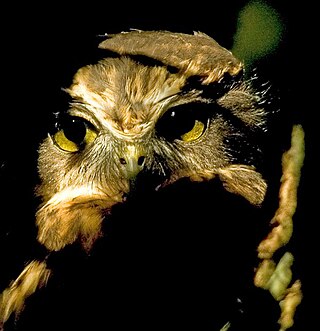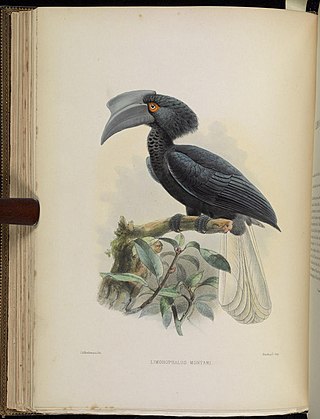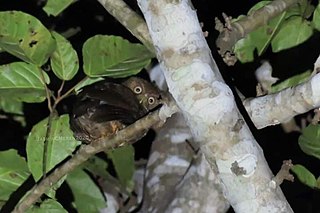
Ninox is a genus of true owls comprising 36 species found in Asia and Australasia. Many species are known as hawk-owls or boobooks, but the northern hawk-owl is not a member of this genus.

The New Britain boobook, also known as the spangled boobook, russet boobook, New Britain hawk-owl or russet hawk-owl, is a small owl that is endemic to New Britain, the largest island in the Bismarck Archipelago in Papua New Guinea.
The Manus boobook, Manus hawk owl, Admiralty hawk owl or Admiralty Islands hawk owl is a small owl. It has an unmarked brown facial disk, rufous crown and back, barred white flight feathers and tail, and whitish underparts with rufous streaking. Its call is repeated growling, like that of a frog.

The Sulu hornbill, or Montano's hornbill, is a species of hornbill in the family Bucerotidae. It is endemic to the Sulu archipelago in the Philippines, with the remaining populations in Tawi-Tawi with it believed to be hunted to extinction on Jolo. Its natural habitat is tropical moist forests. It is threatened by habitat loss as well as potential harvesting for food. Its diet includes fruit, insects, and small lizards.

The Christmas boobook, also known as the Christmas hawk owl, Christmas Island boobook or Christmas Island hawk owl, is a species of owl in the family Strigidae.

The ochre-bellied boobook or ochre-bellied hawk owl is a species of owl in the family Strigidae. It is endemic to Sulawesi, Indonesia. Its natural habitats are subtropical or tropical dry forests and subtropical or tropical moist lowland forests. It is threatened by habitat loss.

The Philippine hawk-owl is a species complex of owls in the genus Ninox. They are all endemic to the Philippines.
The least boobook, also known as the little Sumba hawk-owl or little Sumba boobook, is a species of owl in the family Strigidae. It is endemic to the Indonesian island of Sumba. Its natural habitat is subtropical or tropical moist lowland forests. It is threatened by habitat loss.
The Tawitawi brown dove, also dark-eared brown dove, is a threatened species of bird in the family Columbidae noted for its orange-peach breast. It is endemic to forests in the Sulu Archipelago in the Philippines. Until recently it was considered conspecific with the Mindanao brown dove and collectively called the dark-eared brown dove. Although threatened by habitat loss, the rate of loss significantly reduced from 2004 to 2007, and it was thus downlisted from Critically Endangered to Endangered status in the 2007 IUCN Red List.

The Black shama is a species of bird in the family Muscicapidae. It is endemic to the island of Cebu, Philippines where it is known locally as "Siloy".

The black-bibbed cicadabird or black-bibbed cuckooshrike is a species of bird in the family Campephagidae. It is endemic to the Philippines. The species is elusive and poorly known.

The Sulu pygmy woodpecker, also known as the Sulu woodpecker, is a species of bird in the family Picidae. Formerly lumped with the Philippine pygmy woodpecker, it seems to form a superspecies with this and the Sulawesi pygmy woodpecker. Some taxonomic authorities continue to place this species in the genus Dendrocopos or Picoides.

The Camiguin boobook or Camiguin hawk-owl is an owl species resident to the Camiguin island in the Philippines. It is the only owl in the country with greenish-yellow or grayish eyes. It was previously known as a subspecies of the Philippine hawk-owl, but was reclassified in 2012, as voice and other evidence suggested it a distinct species. Its native name is kugkug

The Luzon boobook or Luzon hawk owl, also Philippine hawk owl or Philippine boobook, is a species of owl in the family Strigidae. It is endemic to the Philippines where it lives in forests. It is a brown and white mottled bird and males and females look much alike.

The Mindanao boobook or Mindanao hawk-owl is a species of owl in the family Strigidae that is endemic to the Philippines on the island of Mindanao. It was previously known as a subspecies of the Philippine hawk-owl, but was reclassified in 2012, as voice and other evidence suggested it a distinct species. It is found in tropical moist lowland forest. It is threatened by habitat loss.

The Mindoro boobook or Mindoro hawk-owl is a species of owl in the family Strigidae that is endemic to the Philippines.

The Romblon boobook or Romblon hawk-owl, is a species of owl in the family Strigidae that is endemic to the Philippines. It is only found on the islands of Tablas, Sibuyan and Romblon. It was previously known as a subspecies of the Philippine hawk-owl, but was reclassified in 2012, as voice and other evidence suggested it was a distinct species. Its natural habitat is tropical moist lowland forest. It is threatened by habitat loss.

The Cebu boobook or Cebu hawk-owl is a species of owl in the family Strigidae. It is endemic to the Philippines. It was formerly considered a subspecies of the Philippine hawk-owl, but was reclassified in 2012, as voice and other data suggested placement in a distinct species.

The black-billed hanging parrot is a hanging parrot native to the Sulu Archipelago of the Philippines. It was formerly conspecific with the Philippine hanging parrot.


















